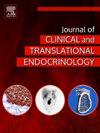甘油三酯-葡萄糖指数和体重指数与糖尿病合并高血压患者5年全因死亡率的关系:来自两项前瞻性队列研究的证据
IF 3.3
Q1 ENDOCRINOLOGY & METABOLISM
Journal of Clinical and Translational Endocrinology
Pub Date : 2025-08-20
DOI:10.1016/j.jcte.2025.100416
引用次数: 0
摘要
目的探讨体重指数(BMI)和甘油三酯-葡萄糖指数(TyG)与糖尿病合并高血压患者5年全因死亡率的复杂关系。方法共纳入1999-2014年美国国家健康与营养调查(NHANES)周期的5728例患者和2005-2010年中国开滦周期的3456例患者。TyG以空腹甘油三酯和葡萄糖浓度的对数乘积计算。结果NHANES人群5年全因死亡率为8.4%,开滦队列为9.2%。TyG介导了BMI和全因死亡率之间的关联,在NHANES数据库中占38.4%,在凯滦队列中占41.6%。TyG与BMI之间存在显著的乘数效应,BMI高的患者乘数更接近。当按BMI和TyG分层时,发现高危亚组的全因死亡率高于中危和低危亚组(均为log-rank P <; 0.001)。结论BMI对糖尿病合并高血压患者全因死亡率的影响中,styg介导了相当大的比例。BMI和TyG的结合可用于全因死亡率的风险分层。旨在减轻体重的措施可能会降低与胰岛素抵抗相关的全因死亡风险。本文章由计算机程序翻译,如有差异,请以英文原文为准。
Relationships of triglyceride–glucose index and body mass index with 5-year all-cause mortality in patients with diabetes and comorbid hypertension: Evidence from two prospective cohort studies
Aims
To characterize the complex relationships of body mass index (BMI) and triglyceride–glucose index (TyG) with 5-year all-cause mortality in patients with diabetes mellitus and comorbid hypertension.
Methods
Overall, 5,728 patients from the 1999–2014 US National Health and Nutrition Examination Survey (NHANES) cycles and 3,456 from the 2005–2010 China Kailuan cycles were included. TyG was calculated as the logarithmic product of the fasting triglyceride and glucose concentrations.
Results
The prevalence of 5-year all-cause mortality was 8.4 % in the NHANES population and 9.2 % in the Kailuan cohort. TyG mediated the association between BMI and all-cause mortality, being responsible for 38.4 % in the NHANES database and 41.6 % in the Kailuan cohort. Significant multiplicative effects were identified between TyG and BMI, which were closer for patients with high BMI. When stratified by BMI and TyG, high-risk subgroups were identified and had higher risks of all-cause mortality than the intermediate- and low-risk subgroups (both log-rank P < 0.001).
Conclusions
TyG mediated a considerable proportion of the effect of BMI on all-cause mortality in patients with diabetes and hypertension. The combination of BMI and TyG could be useful for the risk stratification of all-cause mortality. Measures aimed at weight loss might reduce the all-cause mortality risk associated with insulin resistance.
求助全文
通过发布文献求助,成功后即可免费获取论文全文。
去求助
来源期刊

Journal of Clinical and Translational Endocrinology
ENDOCRINOLOGY & METABOLISM-
CiteScore
6.10
自引率
0.00%
发文量
24
审稿时长
16 weeks
 求助内容:
求助内容: 应助结果提醒方式:
应助结果提醒方式:


